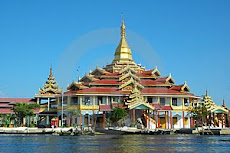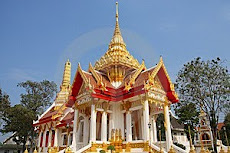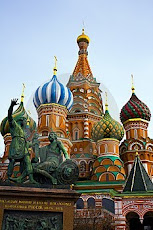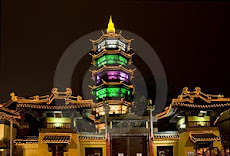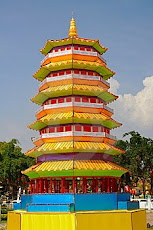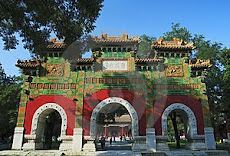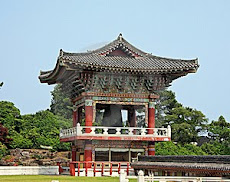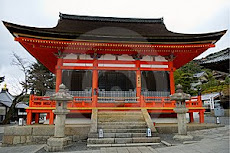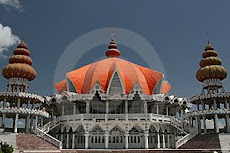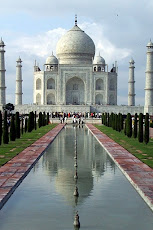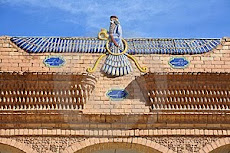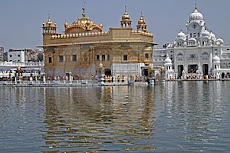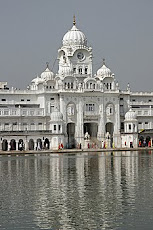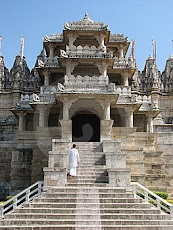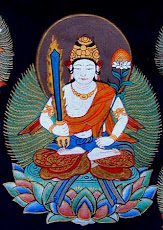The Buddha (ca. 560-480 B.C.) was an Indian philosopher, religious teacher, and the historical founder of Buddhism. He is regarded variously as a human spiritual teacher or an omniscient, active deity.India during the 6th century B.C. was a land of religious and political
turmoil. The Northwest was dominated by the Indo-Aryan invaders who had entered India in the 2d millennium, bringing their own religious and social institutions, which were dominated by a great
sacrificial cult and hereditary
priestly elite, the Brahmins. Their cultural influence was widespread even in areas to the east beyond their political authority. But their claims to religious and social superiority were often regarded as
pretentious and superficial by the older, indigenous
aristocracy.It was an era of great brutality which undermined traditional religious moorings and, for men of deeper religious sensibilities, called into question the value of all
worldly activities and the meaning of life itself. In these circumstances emerged many new religious teachers and schools - all searching for deeper insights into the meaning of existence, the nature of man, and programs of spiritual reconstruction. It was in this environment that young Prince Gautama matured and grew to
manhood.The Buddha ("enlightened one") was born Siddhartha Gautama in northern India near the town of Kapilavastu. His father was ruler of an indigenous Indian tribe, the Shakyas - hence one of the Buddha's traditional epithets, Shakyamuni, or "sage of the Shakyas" - and he was expected to follow in the tradition of a worldly raja.The traditions relate that his father was disturbed by
Gautama's excessive - seemingly
morbid -
preoccupation with the great spiritual enigmas of life: the problems of suffering, death, and the inequities of human existence. The King tried in vain to
insulate him from these harsh realities and built a special palace for him surrounded with distracting luxuries. Gautama married and had a son. But his preoccupation with the great religious questions could not be suppressed, and at the age of 29 he made a decisive move. He formally renounced his worldly commitments, left his family and clan, and embarked on a search for the answers to the massive spiritual questions which
perplexed him.Spiritual Struggles and EnlightenmentGautama was just one of many wandering ascetics, philosophers, and teachers in India during this period who were searching for religious truth. For many of these teachers the basic religious problem was defined by the theory of
transmigration, which, in its most general form, asserts that the human soul (atman) is entrapped in the
phenomenal world by an endless cycle of rebirths (samsara). After death the soul is
reborn in a new physical form depending on the ethical quality of deeds (karma) in the preceding life. The ultimate religious goal is to obtain complete salvation or "release" (moksha) from
bondage to this phenomenal process. For this purpose the spiritual
adept practices the yoga - a system of
inward, ascetic discipline over body, mind, and motivations designed to
cleanse and finally eliminate the debilitating sources of karma and transmigration. This basic teaching was presupposed as the dominant religious problem, though there were sharp disagreements over which teacher had most accurately analyzed the situation and evolved the most
efficacious yoga.The traditions relate that for 7 years Gautama experimented with many different teachings, including extreme
bodily self-mortification, but found none of them adequate. He set them all aside; and at last in a single night of intensive meditation he achieved a radical breakthrough, an absolutely clear perception of the real spiritual enigmas of life and the unique religious means for dealing with them. This realization culminated in a
transcendental mystical experience - his own
enlightenment (bodhi) - which simultaneously confirmed the integrity of his insight and
unqualified spiritual salvation. At this point he became the Buddha.The Buddha's TeachingThere is an interesting legend which reveals some of the problems inherent in formulating the Buddha's teaching. It is told that at the moment of his enlightenment he was entitled to its immediate rewards - complete salvation and spiritual release from the bonds of existence. This would have meant that the doctrine would never have been made known to other men. And there was the additional problem that the inner spiritual meaning of the teaching and its ultimate mystical consequences could not be adequately communicated in any case, except paradoxically through silence. But after debating these issues, the Buddha decided to preach the doctrine anyway, out of his love and compassion for all men. This legend presents a psychological and historical truth: the formal exposition of the teaching is just the top of the
iceberg. Understanding the mystical essence of the teaching and putting it into practice varies greatly, depending on the capacity of its hearers, their needs, and their historical and cultural situation. In a sense, the subsequent history of Buddhism, in all of its immensely varied forms, is proof of this fact.The earliest tradition represents the Buddha as teaching a yoga which was
exoteric - open to all men - and, at least on the surface, simple and eminently practical. It was called the Middle Path, a
qualitative mean between the extremes of physical self-indulgence and self-mortification. The teaching is specifically embodied in the Four Noble Truths. The first of these truths lies in the recognition that all existence is fundamentally
sorrow and pain (duhkha), bound to birth, old age, death, and rebirth and (collectively, samsara) and marked by impermanence (anitya) without lasting essence (anatman). The second truth asserts that this condition is caused by ignorance (avidya) of the nature of reality, especially of the Buddha's teachings, and by
sensual craving (trishna) for worldly existence. This craving in turn is the prime element which at death binds together the
heterogeneous components of the individual human being, including the soul itself, and ties it once again inexorably to the
causal sequence of phenomenal composition and rebirth. The third truth promises that the elimination of these
pernicious factors will finally break the chain of
causation and bring about final salvation, Nirvana (the "blowing out"), release from the transmigrational process and achievement of a state of mystical transcendence beyond expression. The fourth truth shows that to gain this end, the appropriate yoga is the
Eightfold Path, a combination of moral and mental self-discipline which will root out the conceptual and libidinal perversions of the mind that are
inimical to salvation.Despite its apparent simplicity the yoga is described as very demanding, "subtle and hard to understand," since it is only through
arduous practice that real insight, the inner meaning of the truths, self-transformation, and final enlightenment can be attained. Consequenlty, in this form of the teaching there is a premium placed on total commitment expressed in the person of the
celibate monk who has withdrawn from the world for fulltime pursuit of the spiritual goal. A perfected monk is an arahat, or "noble one," who has given his whole life to the yoga.It is important to realize that the teaching is basically
optimistic. It places the broken and disrupted forms of the phenomenal world in perspective and teaches that every human being -
irrespective of his social position or past life - can through his own exertions obtain therapeutic control of himself, of his preconceptions and passions, and of his destiny. The ethical principles gravitate around concepts of compassion (karuna), love (maitri), and noninjury (ahimsa) to living creatures, and they stress the obligation to promote friendship and concord. They are basically universal standards of behavior with obvious constructive consequences for stabilization of
interpersonal relationships and social order.Mission and Monastic OrderThe traditions relate that the Buddha first preached his doctrine (Dharma) in
Benares, India's great holy city on the Ganges. He began his missionary work soon after with a handful of disciples, offering the teaching to all who would hear and understand. The life and discipline of this little band were at first centered on the spiritual authority of the Buddha himself. But as the number of converts and monastic centers grew, the loosely structured community (Sangha) began to take on more formal characteristics. It seems probable that by the time of the Buddha's death, at the age of 80, a number of basic institutional patterns had been set. These included a
disciplinary code, later expanded into the full monastic rule (Vinaya), and a collection of the Buddha's sayings and discourses (Sutra). The major ceremonies included the
bimonthly uposatha, a
confessional assembly of the monks in each monastery to
recite the monastic rules.Despite this appearance of routine
orthodoxy, the early Sangha was not a centralized church under a
bureaucratic hierarchy. In one of his last sermons the Buddha is depicted as rejecting all forms of
magisterial authority or patriarchal succession: "Be lamps unto yourselves, O monks." The main purpose of the monastic rule was to guard the independence of each monk in his own spiritual quest. All fully ordained monks had an equal vote on matters affecting the welfare of the community. When internal disagreements could not be resolved, the dissenters simply left and formed a new community. Monks guilty of infractions against the monastic code were expected to confess and discipline themselves. No form of
coercion could legitimately be invoked.Nevertheless, the institutional problems must have been
burdensome. The Buddha is occasionally represented as perplexed and
disgusted by the
contentious and often
selfish behavior of the monks. On at least one occasion he took time to wash and care for a sick monk who had been callously neglected by his fellows; and his own cousin, Devadatta, is reputed to have started a schismatic movement to replace him as head of the order. He was equally irritated by
abstruse philosophical speculation about topics not specifically relevant to the practice of the yoga, and he likened this kind of
distraction to a man, struck by a poisoned arrow, speculating at length about its point of origin and ballistic curve before trying to pull it out.In keeping with the principle of personal conversion women were admitted to the order; within the monastic community all barriers of caste, race, sex, and previous background were swept under the impact of the universal thrust of the teaching.The LaityAlthough the
ascetic ideal and rigors of the yoga tended to limit monastic membership to those who were fulltime practitioners, the power of the Buddha's personality attracted many lay followers - the "householders." The tradition relates that the Buddha said only that it was harder for the
laity to attain Nirvana; but the bulk of lay
piety gravitated toward a merit-making ethic which could at least guarantee a better rebirth.The Buddhist ethic was significantly oriented to the economic and political needs of urban
mercantile and
artisan groups. At the
outset, lay devotees promised to adhere to the five precepts: no killing, stealing, lying,
adultery, or consumption of alcoholic beverages. In a sermon attributed to the Buddha he advises a well-to-do young
layman to pursue ethical self-discipline for the sake of "well-being in this world and the next," especially the elimination of economically wasteful vices such as
sloth, self-indulgence, and
sensuality. The Buddha is also represented as preaching openly against hereditary caste distinctions, which he regarded as social conventions based originally on occupational differences. "A Brahmin is not such by his deeds, an Outcaste is such by his deeds." And, typically, he reserved the words "Aryan" and "true Brahmin" for members of the monastic community.Buddha's political teachings are basically
contractual and were probably drawn from the oligarchical patrimonialism of his own clan. The king has the obligation to care for his people and, especially, to set high moral standards. A man who fails in this is not worthy to rule. No cult of
divine kingship is proposed. In the traditions the Buddha is represented as consulting frequently with the monarchs of the great states and petty kingdoms, teaching his doctrine and seeking to
ameliorate the conditions of endemic warfare.Later DevelopmentsOne of the most ancient forms of the teaching is in the texts of the Theravada Buddhists, now dominant in Ceylon and the Southeast Asian mainland. But Theravada is the only living remnant of a number of ancient Indian schools. There were schismatic movements both during and after the Buddha's life. One of these gave birth to the forerunners of another great and very different tradition, the
Mahayana ("great vehicle"). This tradition stretches from India through China to Japan and appears in an immense variety of schools ranging from abstruse philosophies to popular
theism and magic. Though its exponents have often stigmatized the
Theravada school as
Hinayana ("small vehicle"), it has produced a massively diverse body of literature which defies uniform characterization.Mahayana is itself closely related to another tradition - the Tantrayana ("esoteric vehicle"), which found one of its central locations in Tibet. Consequently the historical reality of the Buddha's teaching has been
vastly complicated and often obscured over the past 2500 years.Though there were always signs of tension and disagreements over the appropriate interpretation of the Buddha's teaching, it was not until a century after his death that a major
schism developed, based on longstanding points of contention, basic elements of which are most prominently developed in Mahayana doctrine. Although Mahayana literature emerged later, beginning in the 1st century B.C., it claims to present the true and restored teaching of the Buddha.The first point is directed against the conservative ideal of the monk, the arahat, who attains enlightenment only after long and solitary practice of the yoga. For the Mahayana teachers this ideal is a self-centered
perversion of the spirit of the Buddha's teaching, especially his
outgoing love for all men, and instead these teachers developed the notion of the Bodhisattva ("being of enlightement"). This concept originally denoted previous incarnations of the historical Buddha. In Mahayana it signifies one who is essentially worthy of Nirvana but, like the Buddha himself, gives up this right in order to teach and assist all
sentient creatures with compassion and love. All men, including the laity, are held capable of this great role. Typically, one of the great Mahayana texts speaks of a
precocious layman - Vimalakirti - who achieves spiritual perfection far in excess of that of the monks while living a normal householder's life.The second and related point concerns the concept of Nirvana. In his wisdom (prajha) the Bodhisattva knows that Nirvana cannot be conceived of as a simple goal or reward for spiritual striving in the fashion of the arahat. This misconception subtly reinforces the
craving (trishna) for personal
satisfaction and therefore is the
antithesis of salvation. Nirvana is beyond all
spatiotemporal polarities. It is "void" (shunya), and its realization is
inseparable from the
compassionate wisdom which is the distinctive mark of the Bodhisattva.The third point concerns the status of the Buddha himself. In the Hinayana (Theravada) tradition, he is the human founder of the historical teaching, but in Mahayana he is an
omniscient, omnipresent, loving deity. These theistic developments had their roots in lay worship practices which emerged very early in the tradition - perhaps even in the Buddha's own lifetime - as his personal spiritual power promoted the notion that he was a
reincarnation of an eternal sacred reality. The bulk of popular Mahayana throughout Asia became centered on the theistic cult. Believers worshiped many transcendent Buddhas and Bodhisattvas who had the power to answer prayers of petition and to magically transfer merit for the welfare of the
pious. The new mythologies even included a heavenly paradise - a "Pure Land" - available to the faithful through the active grace of the savior
Amitabha (endless light) Buddha.While certain features of these theistic developments are present in the early Indian traditions, altogether they represent later changes and accretions which seem remote from the earliest teaching. But in another sense they are not
untrue to the spirit of the whole. The Buddha is represented, even in the earliest traditions, as tolerant of the necessity of adjusting the teaching to the capacities and background of his adherents. His "skill in means" (upayakaushalya) refers to the technique of doctrinal and institutional adjustment out of compassion for diverse human needs and limitations. And this principle was an important factor in facilitating the missionary
diffusion of Buddhism throughout Asia.Buddha's Modern SignificanceThe immense diversity of Buddhist faith and practice is perhaps its most striking feature. In Tibet the political system was until recently a
theocracy, ruled by spiritual leaders, the Dalai and Panchen Lamas who were regarded as supreme Bodhisattvas, worldly incarnations of the Buddha; and Tibetan Tantrism is a rich synthesis of Buddhist and primitive indigenous teachings.In China and Japan, Zen Buddhism represents a special adaptation of the meditational yoga strongly influenced by Chinese values and regarded as uniquely efficacious by its adherents. In Ceylon and the Indochinese mainland, orthodox Theravada has served as an effective state religion while often
richly infused with primitive animism and magic.In looking for a single point of unity in this extraordinarily complex matrix, it is to be found only in the
paradigmatic grandeur of the Buddha himself, who persists in all the traditions as a model of spiritual perfection and
transcendent saving power



